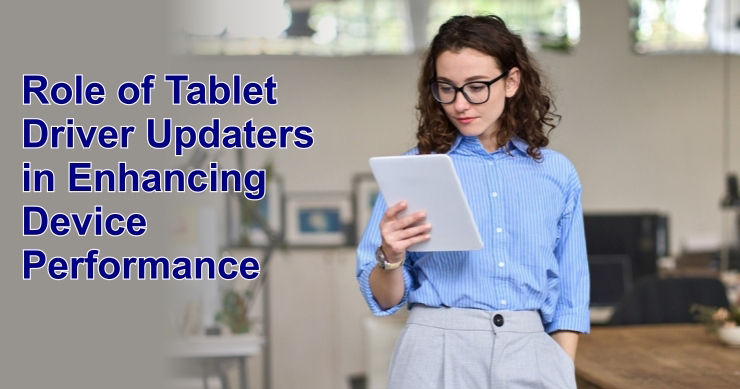Outdated Tablet Drivers Slowing You Down? Here’s How to Fix It
- Audio Driver Updater
- Oct 24, 2024
- 3 min read
In today’s fast-paced digital world, tablets have become essential tools for both work and leisure. However, an often-overlooked aspect of maintaining a tablet's performance is the regular updating of its drivers. Outdated tablet drivers can significantly slow down your device, leading to frustrating performance issues. Thankfully, a Tablet Driver Updater can make this process seamless and efficient. This article explores the problems caused by outdated drivers, the benefits of updating them, and how to effectively install a driver updater.

Understanding Role of Drivers
Drivers are software components that allow your tablet’s operating system to communicate with its hardware, including the touchscreen, camera, and various sensors. Each piece of hardware requires specific drivers to function optimally. Over time, manufacturers release updates to these drivers to enhance performance, fix bugs, and improve security. If these updates are not installed, you may experience several issues, including slower performance, software crashes, and even security vulnerabilities.
Common Symptoms of Outdated Drivers
Sluggish Performance: If your tablet takes longer to open apps or respond to touch commands, outdated drivers could be the culprit.
Frequent Crashes: Unexpected crashes or freezes during usage can often be traced back to incompatible or outdated drivers.
Incompatibility Issues: New applications or updates may not run correctly if your drivers are outdated, leading to a frustrating user experience.
Poor Battery Life: Outdated drivers can cause inefficient power management, leading to quicker battery drain.
Security Vulnerabilities: Cyber threats often exploit vulnerabilities in outdated drivers, putting your device at risk.
Benefits of Updating Your Drivers
Updating your drivers is essential for several reasons:
Improved Performance: Regularly updating your drivers can significantly enhance your tablet's responsiveness and speed. Users often notice a marked improvement in how quickly apps load and run after updates.
Enhanced Security: New driver releases often include security patches that protect your device from vulnerabilities. By keeping your drivers updated you reduce the risk of malware and cyber-attacks.
Increased Compatibility: As new applications are developed, keeping your drivers current ensures the tablet can run the latest software efficiently.
Access to New Features: Driver updates sometimes introduce new features or improve existing functionalities, enhancing your overall tablet experience.
How to Use a Tablet Driver Updater
A Driver Updater is a software tool that automates finding and installing the latest drivers for your tablet. Using the best driver updater can save you time and effort compared to manual updates. Here’s how to effectively use a driver updater:
Choosing the Best Tablet Driver Updater: When selecting a Tablet Driver Updater, look for user-friendly software that offers comprehensive scanning capabilities. The Best Tablet Driver Updater will identify outdated drivers but also provide a straightforward way to update them.
Installing the Driver Updater:
Download from a Trusted Source: Ensure you download the software from a reputable site to avoid malware.
Run the Installer: Follow the prompts to install the driver updater on your tablet.
Launch the Application: Open the software after installation is complete.
Scanning for Outdated Drivers: Most driver updaters will automatically scan your tablet for outdated drivers. Initiate the scan and allow the software to identify which drivers need updating.
Updating Drivers: Once the scan is complete, the driver updater will present you with a list of outdated drivers. Follow the prompts to install the updates. This process is straightforward and can be completed in just a few clicks.
Restart Your Tablet: After the updates are installed, it’s a good practice to restart your tablet to ensure all changes take effect.
Tips for Maintaining Your Tablet's Performance
Schedule Regular Scans: Set your driver updater to scan for updates regularly. Some software allows you to schedule automatic scans, ensuring your drivers are always current.
Backup Your Drivers: Consider backing up your existing drivers. Most driver updaters offer this feature, allowing you to revert to a previous version if an update causes issues.
Keep an Eye on Performance: Monitor your tablet's performance. If you notice any issues, you can restore the previous driver version using the backup feature.
Conclusion
In summary, outdated tablet drivers can significantly hinder your device's performance, leading to frustrating issues that affect your daily activities. Tablet Driver Updater automates the update process, ensuring the tablet runs smoothly and efficiently. Regularly updating your drivers enhances performance and improves security and compatibility with new applications.
Taking proactive steps to install a tablet updater and keeping your drivers current will lead to a much more enjoyable and productive experience. Don’t let outdated drivers slow you down; take charge of your tablet’s performance today!



Comments